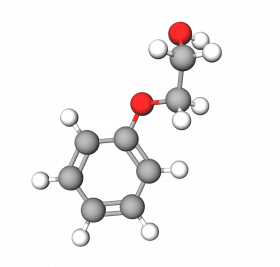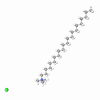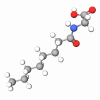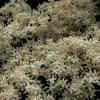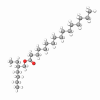A common preservative used for skincare products that have been deemed a safe ingredient. The primary purpose of Phenoxyethanol is to keep bacteria out of our organic ingredients. It is remarkably effective against gram-negative bacteria and fungi. Without a good preservative, the bacteria that can grow on a skincare product are way more harmful than the chemicals themselves.
Thanks to significant antimicrobial action, Phenoxyethanol is a helpful ingredient for formulas to treat dermatological such as acne and mycoses. It can also be used as a plasticizer to improve the product's texture and a fixative agent for fragrances.
Phenoxyethanol is so valuable and healthy that only a tiny amount is required to fight bacteria - that way, there are more potent - beneficial ingredients in the bottle - as opposed to preservatives. It is considered one of the less irritating ones to use in formulations.
Phenoxyethanol does not release formaldehyde. It is a weak biocide, most active against Gram-negative bacteria. It is mostly used in combination with other preservatives. It is stable up to 85C and useful from pH 3-10. It is a free-flowing liquid that can be added easily to most formulations. Phenoxyethanol is typically used at 0.1%.Safety
Preservatives are used to inhibit the growth of microorganisms and thereby keep a product safe for use. Phenoxyethanol - a well-researched and well-tested product that is widely accepted in the industry today by a large number of manufacturers. Amongst all preservatives for cosmetics, Phenoxyethanol has one of the best toxicology profiles.
An effective preservative for cosmetics and pharmaceuticals, Phenoxyethanol has been recognized and approved as a preservative around the world. This includes international bodies like the Cosmetic Toiletry Fragrance Association, the USA, the European Economic Community, and the Japanese Ministry of Health and Welfare. It is also a listed preservative in British Pharmacopoeia and US Pharmacopoeia.
Dual-acting Antimicrobial action
It exhibits high efficiency and broad-spectrum effectiveness. Phenoxyethanol mounts a two-pronged attack. It associates with the bacterial cell wall, thereby disturbing cell biological activity and preventing reproduction. It also causes irreversible leakage of materials through the cell wall, thereby depleting the cell of nutrients and killing it.
This two-pronged action makes Phenoxyethanol a highly efficient preservative - a double-edged sword that helps you win. The antimicrobial activity of Phenoxyethanol is broad spectrum. So it is effective against a wide range of microorganisms, which includes gram-positive bacteria, gram-negative bacteria, yeast, and molds. This makes Phenoxyethanol a highly effective preservative as well. In fact, studies have shown that Phenoxyethanol is far more potent against gram-negative bacteria than most other preservatives.Compatibility
Phenoxyethanol enjoys excellent compatibility with most cosmetic ingredients. In fact, several common ingredients enhance its activity. Potential enhancers include alcohols, antioxidants, and EDTA.
Toughness Unlike many other preservatives, Phenoxyethanol is a very stable molecule. It has no labile, or susceptible functional groups. Even under extreme conditions, it does not degrade, decompose, or give out noxious vapors.
Resistance to Adaptability
Microorganisms have diverse metabolic capabilities and are able to utilize virtually any organic compound as a substrate. So, they have the ability to adapt even to inhospitable environments over a period of time such that they are able to grow even in adequately preserved cosmetics.Experiments conducted with many strains of bacteria like Pseudomonas aeruginosa, E. coli (gram-negative), and Staphylococcus aureus (gram-positive) in 1985 have demonstrated that these microorganisms were able to adapt to all preservatives except Phenoxyethanol.
The inability of microorganisms to adapt to Phenoxyethanol makes it invaluably more effective than other preservatives. Its potency against microbial attack remains intact despite repeated challenges.
Long-lasting Efficiency
Because of its stability and the inability of microorganisms to adapt to it, Phenoxyethanol is always there to protect the product and consumer... the last to leave the battlefield...victorious.Synergy in Preservation
The incorporation of parabens along with Phenoxyethanol is proven synergistic. Formulators can take advantage of this synergy while selecting preservative systems with it.
Ease of Incorporation
A colorless liquid, Phenoxyethanol is very convenient to incorporate in a cosmetic formulation. Unlike other preservatives, it is soluble in both oil and water. It gets dispersed uniformly throughout the cosmetic formulation. It can act as a solvent for other solid powder preservatives like parabens.
Usage Levels
In general, it has been found that about 0.6-0.8% Phenoxyethanol (or a synergistic combination of 0.3-0.4% Phenoxyethanol, 0.1% Methyl Paraben, and 0.01% Propyl Paraben) brings about adequate preservation in a cosmetic formulation.However, as the amount of preservative required in a cosmetic or a pharmaceutical formulation would vary considerably depending on the ingredients, process, and application of the formulation, we would recommend that manufacturers decide on the required preservative level accordingly.
What are the benefits of Phenoxyethanol?
Phenoxyethanol is a universal preservative with practically good effectiveness against the growth of microbes, including bacteria (gram-positive and negative), fungi, yeast, and even molds. Other benefits include:
- Suitable for a broad range of formulations from cleansing to eye care (compatible with surfactants, foundations, and other ingredients)
- Water solubility beyond the standard concentrations in the formula
- Stable performance in a wide range of pH values from 3 to 8.5
- Non-irritating in typical concentrations for skin, even for eyes and mucous membranes
- Hypoallergenic - practically no evidence of skin sensitization
- Low volatility in room temperatures and stability in higher degrees up to 176°F
- No loss of effectiveness in prolonged storage and increased shelf life.
